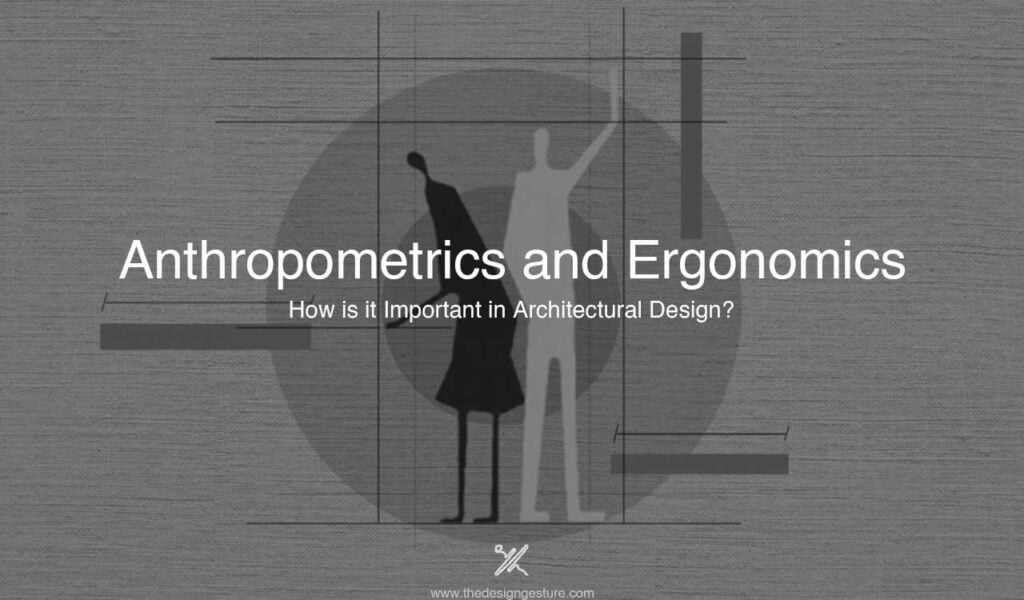Table of Contents
Introduction
Leonardo da Vinci intended to memorialise Vitruvius’s description of man’s ideal human body 500 years ago. To do so, he meticulously measured and combined dimensions, resulting in the Vitruvian Man, one of the most famous depictions of the human form in the world and one of the first sources of anthropometrics recommendations.
Anthropometrics of Vitruvian Man
In 1955, Le Corbusier designed a model known as ‘the Modulor,’ which further established humans ‘ideal ratios’ that should be considered in the creative architectural process. These were used to determine requirements for spaces such as doors and other functional objects within architecture where space constraints must be limited but still functional. They were also used to define requirements for seating, worktop heights, and other functional things.
Modulor Man by Le Corbusier
Anthropometrics is the comparative study of the human body’s measurements and capabilities. The essential premise of anthropometrics is that buildings should adapt to the human body rather than the other way around.
Anthropometry is the foundation of building standards in architecture, which give a set of standard requirements and acceptable solutions for various designs. It plays a significant role in optimizing building design and impacts a wide range of businesses, processes, services, and products. When it comes to establishing the proportions and general design of a structure, human dimensions and capacities are crucial. Anthropometrics is used in building design to ensure that everyone is as comfortable as possible. In a practical sense, this implies that the room’s dimensions must be acceptable, with high ceilings, broad doorways and hallways, and so on.
While anthropometrics involves the systematic measurement of the physical properties of the human body as height, weight, shape, arm length, etc. Ergonomics involves incorporating anthropometric data to improve people’s interactions with products, systems, and environments.
The term “ergonomics” was first used in 1949 when a group of people decided to start a new society called “Ergonomics Research Society.” They concentrated on creating and finding knowledge about human traits that can be applied to the design of systems and equipment. These discoveries are made to determine the optimum ergonomic design method. During World War II, society arose due to the work and expertise of numerous specialists working in the current operating systems at the time.
These systems included those used on the Earth’s surface, beneath the sea, and in space. Their research was critical for situations where humans are not in a comfortable or familiar environment, such as outer space or beneath the sea, where the ergonomics of space architecture can be incredibly beneficial tools.
Ergonomists work across and employ methodologies from various disciplines, including Biomechanics, Environmental physics, Applied psychology, and Social psychology, in addition to Anthropometry.
Because all the interconnected aspects of our environment must be considered together to construct the space, successful ergonomic design is a holistic endeavour. Good posture, fewer repetitive motions, better heights and reaches, less exertion, and more efficiency are all characteristics of an ergonomic workspace. Ergonomics covers everything under the sun, thus when it comes to architecture ergonomics, it’s about anything tangible, not just furniture.
Using anthropometry, the amount of space needed for different furniture and fixtures is decided. When building a home setting, for example, an architect must consider the most comfortable and efficient ways to move around a place while still maintaining a visually appealing design. A bathroom, for example, must have enough space to comfortably fit a bathtub and sink; a bedroom must have enough space to comfortably fit an average-sized bed; and an office building must have enough space to comfortably fit desks, air conditioning units, public areas, meeting rooms, and so on.
In a kitchen, there must be enough space to move around freely while yet being able to reach various cupboards, drawers, and utilities with ease and frequency. The kitchen work triangle is an ergonomic innovation for kitchen space, where the three major working functions of a kitchen, the refrigerator, sink, and stove, are close enough to each other but not too close to make someone feel trapped and uncomfortable, allowing them to work efficiently in the space. Ergonomics has become increasingly important in recent years for office design and the interplay between desk, chair, keyboard, and computer display, especially when the culture of work from home and hybrid offices is on the rise.
So, technically, anything tangible, from a doorknob to a building’s roof, may be designed using ergonomics by developing the feature according to the user’s needs, making it safe and long-lasting to use. The ability to create an ergonomic environment is critical for human resourcefulness and utility.
Approach towards accessibility
Using models of the Vitruvian man, architects might have sculpted the world into an idealised standard “infused with gender, class, and embodiment of health and normality.” However, these standards may not represent the diverse nature of all body forms.
More than 1 billion persons in the world have a physical or mental disability, making up 15% of the population, as per the ‘World report on disability’. If one defines disability as the difficulty accessing public services for all kinds of reasons, even social or economic, then the proportion goes up. Across society, disabled people face exclusion, which is strongly evident in their interaction with the built environment. One of the sources and sites of this marginalisation relates to architecture. A wheelchair user is less disabled when in a space with no stairs.
Accessible design is the design of products and environments to meet the functional limitations of people with disabilities. Given demographic and social phenomena of the 21st century, related with the change of the society’s age structure, medical care progress, and, above all, the elderly and disabled persons’ efforts to lead independent and content lives, designing accessible space is becoming an imperative of residential architecture. The solutions of spaces designed only for non-disabled persons differ significantly from space solutions for persons with restricted mobility, particularly in the ergonomics of accessibility zone levels.
Our culture is now shifting to a socially responsible and inclusive atmosphere for many minority sub-groups, but the Built Environment‘s fabric struggles to upgrade at the same pace. Incorporating accessible design in planning ensures comfort to everyone, not restricting it to people with disabilities. An adaptable design makes good economic sense as it minimises the need for customised design solutions. When we create spaces that get it right for the disabled, they will meet the needs of most people and the wider community, boasting clientele from these specific groups. Creating an inclusive and accessible world will benefit everyone, allowing every section of society to feel confident of finding their voice unaided in the world.
Author

Currently in her 4th year of Architecture at IIT Roorkee, Avantika believes that architecture is a tool for meeting people’s aspirations and providing them with better experiences. When coupled with design thinking, architecture and research have the potential to enrich our societies and have a constructive impact. Creating socially, culturally, and environmentally sustainable spaces is what architecture means to her. Her experience as an architecture student has shifted her world view and taught her to be more observant and empathetic.





Hi Avantika,
I was really impressed by your writing on accessible design, I truly believe that this is one of the areas where a lot of work can be done and is personally close to my heart. I also liked your thought in your profile section.
Wishing you the very best in creating some amazing spaces.
Ciao,
K